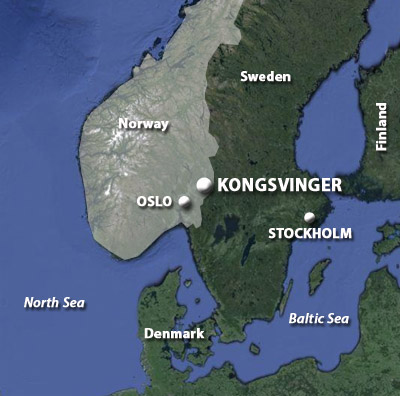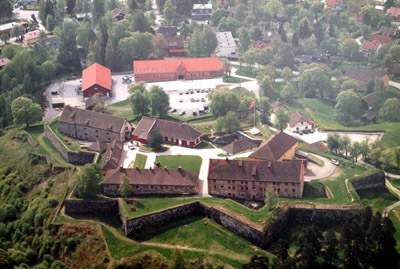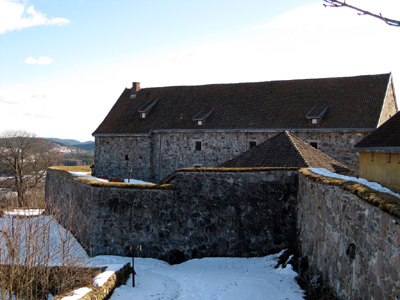 |
Kongsvinger Fortress
Kongsvinger, Norway
|
|
 |
Constructed: 1680 - 1684
Used by: Norway, Germany
Conflicts in which it participated:
None
|
Kongsvinger Festning, or King's Wings Fortress, did such a good job of scaring the pants off of all of Norway's enemies for three centuries that it never came under attack, despite Sweden in particular's dearest desire to do so.
To travel the ancient road from Sweden to Oslo, Norway's preeminent city, one must ride a ferry o'er the Glomma River at a place called Tråstad. This is at a convenient bend in the river known as Glomma Knee, which was first fortified with some sort of bulwark in 1658, lest any of those bumptious Swedes get any fancy ideas about marching on Oslo: Norway was already an unwilling part of a union with Denmark, and didn't feel the need to be "unified" with anyone else, tusen takk. |
 |
 |
|
|
 I question the wisdom of having buildings inside your starfort that are too tall to be protected by the fort's walls. But then I'm no Norwegian. |
 |
Work commenced in 1678 on a more powerful fortification on Tråstad Berget, the hill that overlooks Glomma Knee. This effort was commanded by Lieutenant Anthony Coucheron (1650-1689), a military engineer who had been involved in the construction of Fredrikstad Fortress. The work at Trâstad was enticingly known as Golden Borg, and seems to have been kind of like a starfort; a square with three corner bastions. Golden Borg was garrisoned in 1774, but soon King of Denmark and Norway Christian V (1646-1699) demanded that a fortification that would be better able to withstand an attack from strong siege artillery be built there instead. |
|
|
Johan Caspar von Cicignon (1625-1696), a Luxembourgian in the service of King Christian V and former commander of semistarfort Bergenhus, was tapped to devise such a work. Cicignon's design was deemed too extensive and expensive, however, so Anthony Coucheron was given the opportunity to improve upon his previous work. Coucheron designed and built an irregularly-shaped star, with walls ranging from six to ten feet tall.
In the interest of eliminating confusion in the heat of notional battle, a starfort's bastions, and/or gun batteries, are often individually named. The religious obfuscation-loving Spanish tended to name their bastions in a long-winded fashion after Catholicism's infinite saints, while the puritanical Americans often used such colorful names as, "Number 1 Battery." The names of the bastions of Kongsvinger Fortress changed over time, but the names that are generally agreed upon these days are: King Battery, Queen Battery, Crown Prince Battery, Prince Carl Battery, Prince Wilhelm Battery, Gyldenløves Battery and Wedels Battery.
|
Though construction and improvement continued for another century, the main structure of Kongsvingen Festning was complete by 1684. For many years, the fort's flagpole was used as Norway's geographic central mapping point. Which is weird, because it sure doesn't seem like the center of anything, but if you take Denmark and Norway together, maybe?
Whatever, the Fortress, once completed and garrisoned, started collecting a settlement of families, craftsmen and merchants who supported the fort. The town of Kongsvingen was thus born.
|
 |
|
|
The Gyldenløves Tower, a three-story tower that had been part of the original Golden Borg, was used to store the Fortress' gunpowder. Yes, powder in a tower. It was struck by lightning on June 30, 1733, with predictable results to both the tower and surrounding buildings. King Christian VI (1699-1746) arrived on the scene on July 7, and determined that another tower should be built in the exact same spot. The structure that replaced the ill-fated powder tower was completed in 1737, and known as, and I am not making this up, the Big Krud Tower, which is an even better name than Golden Borg.Kongsvinger Fortress was never attacked, though Swedish forces made it as close as the far side of the Glomma River on two occasions, during a series of fun little wars betwixt Norway and Sweden through the 18th century. Denmark/Norway chose the wrong side in the Napoleonic Wars of the beginning of the 19th century, understandable in that Great Britain attacked Denmark's capitol city of Copenhagen (Starfort therein: Kastellet!) in both 1801 and 1807, on the latter occasion practically destroying the entire city and killing some 2000 civilians. These attacks were to prevent the otherwise quasi-neutral Danish/Norwegian Navy from aiding the French, but served only to drive the Danish Kingdom into an alliance with Napoleon (1769-1821). Once Napoleon was defeated, however, the Treaty of Kiel (1814) not only dissolved the union betwixt Denmark and Norway, but also awarded Norway to Sweden. Because somebody's gotta have Norway, and Norway certainly can't be responsible for itself.
|
 |
 |
Happily, Norway and Sweden agreed to go their separate ways in 1905. Though a couple of modern gun batteries were built in Kongsvinger at that time just in case Sweden wanted to duke it out, the new armament proved unnecessary.
Norway declared its neutrality at the start of the Second World War (1939-1945). Some German naval and air force personnel were detained at Kongsvinger Fortress in 1939: They were not prisoners of war, but detainees, see. Neutrality notwithstanding, Germany invaded Norway on April 9, 1940, and the Fortress was occupied by those sneaky Nazis, who set up "SS and Gestapo schools" therein. |
|
|
After the war, the Norwegian army used Kongsvinger Fortress as an Officers Candidate School for artillery, until it was moved elsewhere in 1959. Today there is a museum in the fortress' Provisions House, which was built in 1682. The Fortress Games are held within the fort's walls annually, and the first weekend of July sees the Our Kong Festival and/or various music concerts. And I must say that, were I able to visit the remains of Golden Borg during the Our Kong Festival and discuss the Big Krud Tower, I could die a happy man.
|
|
|
|
|
|
 |




